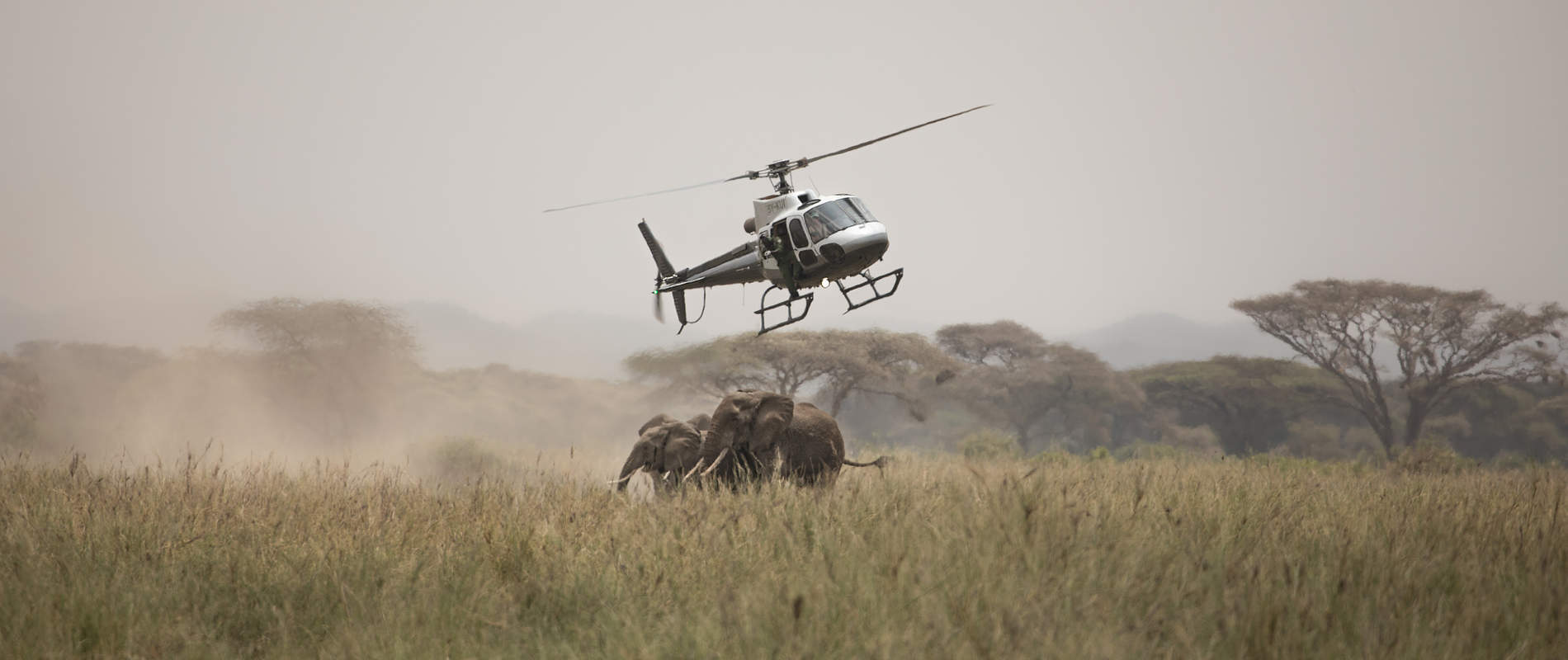February saw an increase in illegal activities in the Parks – especially poaching. Numerous poachers’ harbours were sighted and destroyed during helicopter patrols, including four fresh harbours.
On one occasion, the helicopter was called out to Galana Ranch after a ground team discovered tracks of a heavily laden motorbike (thought to be carrying bushmeat). Despite an extensive search, no suspect was found. Two other poaching-related callouts were responded to, the first being an incident involving 8 individuals sighted by KWS attempting to load 8 sacks of bushmeat onto a waiting truck on the Mombasa Highway. The men dropped the sacks and ran into thick bush. After losing the men’s tracks, KWS requested aerial assistance from SWT and two aircrafts (1 helicopter and 1 fixed-wing) were deployed to aid in the search. Unfortunately, the men had made a clean getaway. Another callout involved one of the K9 Unit dogs and a handler transferred to Ithumba to follow fresh spoor that had been spotted by a ground team.

Several elephant carcasses were found in February, two of these were confirmed poaching victims. KWS and SWT came together in an extensive operation after their discovery and a poacher in possession of ivory was later arrested. On the 17th February an aerial patrol on Galana Wildlife Conservancy discovered an old carcass of an elephant, which was a suspected drought victim, with its handsome ivory intact. Another carcass, although discovered with both tusks intact, was in close proximity to where a poachers’ harbour had recently been uncovered with 13 poisoned arrows. It is therefore likely that the elephant was shot by poachers and died later, after the poachers had lost its tracks.

In addition to an increase in poached carcasses found, the Aerial Unit responded to a large number of veterinary callouts. Two cases sprang up on Rukinga Ranch, both involving snared animals. These included an elephant with a snared foot and a Grevy’s Zebra with a deeply cutting snare around its head, severing both its ears. Despite the severity of both wounds, these animals are both expected to make a complete recovery.

Corresponding to the carcasses also found in the Northern Area of Tsavo East, two elephants were treated in the area with fresh arrow wounds. The first of these was a large bull elephant seen first at the Ithumba Stockades by our keepers and later relocated with the help of a fixed-wing aircraft, and subsequently darted from a helicopter for a successful treatment. The second bull was sighted during a helicopter patrol with an arrow wound on its back and later also darted and treated. In this instance, the vet’s trip to Ithumba was facilitated by a ride in one of the Trust’s fixed wing aircraft. A poisoned arrow was removed from the wound on his back, confirming that this was a poaching attempt.

The helicopter was also instrumental in the darting and treatment of an elephant in Kimana Sanctuary with a severe spear wound to the ankle. After cleaning the wound and administering antibiotics, the vet was confident of a full recovery. Finally, a female elephant found in community land north of Lake Jipe was treated for a gunshot wound to the leg. Unfortunately, despite being given a strong dose of antibiotics, she later succumbed to an infection and died. Bullet wounds to the leg are notoriously difficult for elephants to recover from, especially when bone is involved.

Two elephant calf rescues were also conducted during the month. The first was a 4-6 week old calf found trapped in a sandy well dug in a river bed by communities in Shompole and rescued and brought to Kaluku HQ by helicopter to be cared for. The second calf had been involved in a Human-Elephant Conflict (HEC) incident in Turkwel, Northern Kenya. A seventeen-year-old cattle herder was struck down by an elephant and during the commotion that ensued, while the community rallied to assist the young man in getting to hospital, the herd evidently fled, leaving a young calf stuck in the fork of a tree. SWT was called to collect the calf in our Cessna Caravan. Thankfully, the young herds boy made a full recovery.

Five other HEC incidents were responded to in February. Two of these were unsuccessful searches for elephants that had been reported inside the community; however, on three other occasions, elephants were pushed either by helicopter or fixed wing away from community land and back into protected areas. The most significant incident involved pushing a herd of 28 elephants out of farms near Sagalla Hill and back into safe ranch land.

Livestock remains mostly under control in Tsavo East, with small numbers of livestock being detected along the boundaries (mostly East and South). Progress continues to be made in Tsavo West, where numbers of livestock are historically low for this time of year, in a drought. Chyulu Hills, however has experienced an influx of livestock. KWS, with assistance from our helicopter was able to land at several bomas and destroy them. Additionally, two helicopters were deployed after a sighting of two herders attempting to break into the Trust’s radio repeater room atop the Chyulu Hills. Teams were deployed to multiple locations to try and locate the men, and while they were not discovered at that time, the teams successfully set an ambush at the men’s temporary livestock enclosure, which was discovered nearby, and arrested the two men who had been sighted trying to break into the radio repeater room.

Other activities noted were logging in Northern Tsavo East as well as extensive charcoal burning activities on Kulalu and Galana Ranches. On one helicopter patrol, a fresh loggers’ harbour was discovered and when ground teams arrived on site, it appeared that the loggers had escaped narrowly, leaving behind their possessions, which were duly confiscated.
